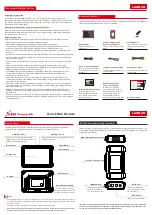
S
ystem Design
23
In
tr
oduct
ion
1
Hard disk capacity requirements
It is assumed that you use continuous recording at a fixed frame rate (number of images per second), image size and
quality. The size of the recording file varies depending on how the camera is configured (the settings for image quality and
size) and the complexity of actual scene.
Follow these steps to determine the required hard disk capacity.
The higher the image quality setting, the higher the image quality and resulting data volume.
For general security purposes, you can use 1 to 2 fps. Higher frame rates require more hard disk space.
We recommend that you add 10 to 20% more space to the calculated hard disk capacity.
Sample calculations for each video format are shown below, assuming 1000 Kbps = 1 Mbps for the network bandwidth,
and 1024 KB = 1 MB for the disk capacity.
Example 1: JPEG recording
• Image recording from 16 cameras (VB-C60)
• Image size is 320 x 240 and image quality is 3 (data size per frame: 12.5 KB)
• Recording frame rate is 2 fps
• Data size per second is approximately 25 KB (= 12.5 KB x 2 fps)
Although the actual recording file size depends on the objects recorded by each camera, this calculation assumes the
typical sizes given above.
• Audio is recorded from 2 cameras
If JPEG images from 16 cameras are recorded at 2 frames per second in continuous recording mode, the required hard
disk space is approximately 33 GB per day (= 25 KB x 16 cameras x 60 seconds x 60 minutes x 24 hours = 34,560,000 KB).
If audio data is recorded using 2 cameras, the required hard disk space is approximately 1.3 GB per day (= 8 KB x
2 cameras x 60 seconds x 60 minutes x 24 hours = 1,382,400 KB).
Example 2: MPEG-4 recording
• Image recording from 8 cameras (VB-C60).
• Image size is 320 x 240 and image quality is 3.
• Recording frame rate is 30 fps.
• Data size per second is approximately 150 KB.
Although the actual recording file size depends on the objects recorded by each camera, this calculation assumes the
typical sizes given above.
If MPEG-4 images from 8 cameras are recorded at 30 frames per second in continuous recording mode, the required hard
disk space is approximately 99 GB per day (= 150 KB x 8 cameras x 60 seconds x 60 minutes x 24 hours = 10,368,000 KB).
1
Decide on the number of cameras and the image size for recording.
2
Decide on the image quality for each camera.
3
Decide on the frame rate required for recording.
4
Decide on the number of hours per day to record and the number of days to store the recorded data.
5
After deciding on the above parameters, calculate the required hard disk capacity based on the recording file size (in KB).
6
If you will also record audio, be sure to calculate the additional amount of hard disk space required for the audio.
Summary of Contents for RM-Lite
Page 12: ...12 ...
Page 30: ...30 ...
Page 31: ...Chapter 2 Setup How to install the software Settings after installation ...
Page 36: ...36 ...
Page 54: ...54 ...
Page 55: ...Chapter 4 Viewer Settings Configuring the Viewer Configuring a camera Creating a layout ...
Page 70: ...70 ...
Page 92: ...92 ...
Page 106: ...106 ...
Page 112: ...112 ...
Page 116: ...116 ...
Page 137: ...Index 137 Appendix ...
















































